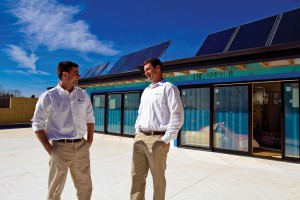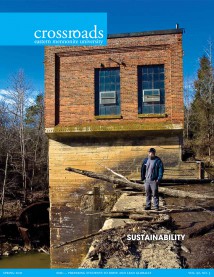Judging from the number of alumni who contacted Crossroads about living in, or building for others, “green” houses, the majority of graduates from EMU by 2021 will end up living in homes that consume dramatically less energy than their parents’ and grandparents’ homes, while being built with materials from one’s local area that pose few hazards to health. Here are a half-dozen alumni who are leading the way to green buildings.

Alex Ivanitsky ’02 and A. Neal Lewis, class of ’01, former EMU basketball teammates, own Sustainable Solutions of Virginia. They were the general contractors for this three-unit townhouse building, which includes passive solar design, solar water heaters and other green features.
Alex Ivanitsky ’02 and A. Neal Lewis, class of ’01, started a construction company in Harrisonburg, Virginia, soon after their college years. A few years later, after Lewis took coursework in sustainable design at EMU, the pair renamed the company Sustainable Solutions of Virginia and refocused their business on sustainable construction practices. Both have since received further training in solar hot water system installation, energy auditing and home weatherization. Their company now partners with Energy Star, EarthCraft House and the US Green Building Council. This spring, Sustainable Solutions is installing Harrisonburg’s first multi-family residential solar water heating system as part of a project to decrease energy costs for low-income housing.
Aaron Yoder ’01 owns A M Yoder & Co., a Harrisonburg home construction and remodeling company that uses the EarthCraft House program. Compared to conventional building, EarthCraft House projects generate less waste during construction, require less energy for climate control and demand less ongoing maintenance. A M Yoder & Co. applies these techniques to a wide variety of houses. The company can build a Habitat for Humanity home that uses 40 percent less energy, and an 8,000-square-foot luxury home that is far less resource-intensive than a conventionally built mansion.
Benjamin Meredith ’92 is owner and president of Building Knowledge: Professional Inspection Services (Harrisonburg), which conducts home and small business energy audits to identify the best ways to reduce energy consumption. It also provides third-party verification for homes built to Energy Star or EarthCraft green building standards. Meredith uses construction expertise and specialized equipment – duct blasters, infrared cameras – to understand and improve a building’s energy usage. “Residential buildings consume approximately 22 percent of the energy consumed in the United States,” he says. “It is my job to help people figure out how they can reduce their energy consumption footprint.”

Pictured on the job in Raleigh, North Carolina, Bradley Yoder ’02 works as a project adviser for Build Sense, a green design and construction company. The Raleigh project pictured here will earn a Gold certification, as defined by the National Green Building Standard.
Bradley Yoder ’02 is project adviser for Build Sense, based in Durham, North Carolina. It builds all its new homes to the National Green Building Standard of the National Association of Home Builders. Smart and efficient homes, Yoder says, are a key part of living well-balanced lives: “If you’re careful about building [people’s] homes responsibly, efficiently and healthily, [they] are better equipped to do what they want with their lives.” One of Bradley’s colleagues, John Price, class of ’76, is the “build lead” at Build Sense, overseeing several of the company’s construction crews. Through another company, Carolina X Wall, Yoder also sells insulating concrete forms, an efficient and eco-friendly building material.
In Fulks Run, Virginia, Heather Bauman ’04 and Justin Thomas Yoder, class of ’03, live in a passive solar house, with supplementary heat from a masonry stove. It has a lightcolored metal roof to ward off summer heat. Built by Justin and his father, Kenton E. Yoder, the house stays comfortable during summers without air conditioning, says Heather.
